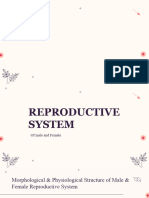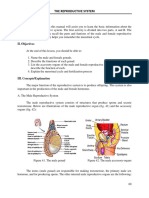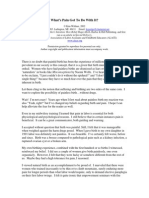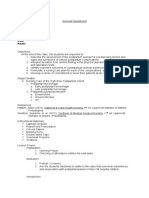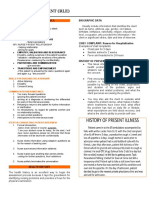Adult males and females produce specialised reproductive germ cells, called gametes.
The male
gametes are called spermatozoa, and the female gametes are called ova.
They contain the genetic material, or genes, on chromosomes, which pass inherited
characteristics on to the next generation.
At fertilisation, the fusion of an ovum and a spermatozoon, the resulting cell is called a zygote
The reproductive system is the biological system responsible for producing gametes (sperm and
eggs), facilitating fertilization, and supporting the development of offspring. It encompasses both
male and female reproductive organs, along with associated structures and hormones.
Functions of the Reproductive System:
• Gamete Production:
The primary function is to produce and release gametes (sperm in males, eggs in females).
• Fertilization:
The reproductive system facilitates the meeting and fusion of sperm and egg cells, leading to
fertilization and the formation of a zygote.
• Pregnancy and Development:
In females, the reproductive system supports the development of a fetus during pregnancy,
providing an environment for growth and nourishment.
• Hormone Production:
The reproductive system plays a crucial role in producing sex hormones, which are essential for
sexual development, maturation, and reproductive function.
• Sexual Function:
The reproductive system enables sexual function and the ability to reproduce.
Key Components of the Reproductive System:
• Gonads:
�These are the primary reproductive organs – testes in males (producing sperm and testosterone)
and ovaries in females (producing eggs and estrogen/progesterone).
• Ducts and Accessory Glands:
These structures are involved in the transport, storage, and maturation of gametes, as well as
providing fluids and nutrients to support reproduction.
• External Genitalia:
These are the external reproductive organs, including the penis in males and the vulva in
females.
• Hormones:
The reproductive system produces and regulates hormones, such as testosterone, estrogen, and
progesterone, which are crucial for sexual development, maturation, and reproductive function.
Male Reproductive System:
• Testes: Produce sperm and testosterone.
• Scrotum: Houses the testes and regulates their temperature.
• Epididymis: Stores and matures sperm.
• Vas Deferens: Transports sperm from the epididymis to the urethra.
• Seminal Vesicles: Produce fluid that nourishes sperm.
• Prostate Gland: Produces fluid that helps sperm move.
• Penis: Delivers sperm into the female reproductive tract.
Female Reproductive System:
• Ovaries: Produce eggs and hormones.
• Fallopian Tubes: Transport eggs from the ovaries to the uterus.
• Uterus: Provides a place for the fertilized egg to implant and develop.
• Vagina: Receives the penis during sexual intercourse and serves as the birth canal.
• Cervix: Connects the uterus to the vagina.
• Vulva: The external genitalia of the female.
STRUCTURES OF FEMAL REPRODUCTIVE SYSTEM:
External Genitalia (vulva):The external genitalia are known collectively as the vulva, and consist
of the labia majora and labia minora, the clitoris, the vaginal orifice, the vestibule, the hymen
and the vestibular glands (Bartholin’s glands).
�Internal Genitalia: The internal organs of the female reproductive system lie in the pelvic cavity
and consist of the vagina, uterus, two uterine tubes and two ovaries.
Uterus: The uterus is a hollow muscular pear-shaped organ, flattened anteroposteriorly. It lies
in the pelvic cavity between the urinary bladder and the rectum
Fundus: This is the dome-shaped part of the uterus above the openings of the uterine tubes.
Body: This is the main part. It is narrowest inferiorly at the internal os where it is continuous
with the cervix.
Cervix (‘neck’ of the uterus): This protrudes through the anterior wall of the vagina, opening
into it at the external os.
The walls of the uterus are composed of three layers of tissue: perimetrium, myometrium and
endometrium
The fallopian tubes are bilateral conduits between the ovaries and the uterus in the female
pelvis. They function as channels for oocyte transport and fertilization.
Ovaries: The ovaries are the female gonads (glands producing sex hormones and the
STRUCTURES OF MALE REPRODUCTIVE SYSTEM:
Scrotum: The scrotum is a pouch of deeply pigmented skin, fibrous and connective tissue and
smooth muscle. It is divided into two compartments each of which contains one testis, one
epididymis and the testicular end of a spermatic cord. It lies below the symphysis pubis, in front
of the upper parts of the thighs and behind the penis.
Testes :The testes are the reproductive glands of the male and are the equivalent of the ovaries
in the female. They are about 4.5 cm long, 2.5 cm wide and 3 cm thick and are suspended in the
scrotum by the spermatic cords. They are surrounded by three layers of tissue:
Tunica vaginalis,
Tunica albuginea
Tunica vasculosa
The ductus deferens, or vas deferens, is a fibromuscular tube that is continuation of the
epididymis and is an excretory duct of the testis.
The epididymis is a long, coiled tube that rests on the backside of each testicle. It carries and
stores sperm cells that are created in the testes. It's also the job of the epididymis to bring the
�sperm to maturity — the sperm that emerge from the testes are immature and incapable of
fertilization.
Seminal vesicles :The seminal vesicles are two small fibromuscular pouches lined with
columnar epithelium, lying on the posterior aspect of the bladder. At its lower end each seminal
vesicle opens into a short duct, which joins with the corresponding deferent duct to form an
ejaculatory duct.
Prostate gland: The prostate gland lies in the pelvic cavity in front of the rectum and behind the
symphysis pubis, surrounding the first part of the urethra. It consists of an outer fibrous
covering, a layer of smooth muscle and glandular substance composed of columnar epithelial
cells.
Urethra: The male urethra provides a common pathway for the flow of urine and semen, the
combined secretions of the male reproductive organs. There are two urethral sphincters. The
internal sphincter consists of smooth muscle fibres at the neck of the bladder above the
prostate gland. The external sphincter consists of skeletal muscle fibres surrounding the
membranous part.
Penis: The penis has a root and a body. The root lies in the perineum and the body surrounds
the urethra. It is formed by three cylindrical masses of erectile tissue and smooth muscle. The
erectile tissue is supported by fibrous tissue and covered with skin and has a rich blood supply.
COMMON CONDITIONS:
Pelvic inflammatory disease (PID): This condition is usually a consequence of sexually
transmitted infections. It usually begins as vulvovaginitis and may spread upwards to the cervix,
uterus, uterine tubes and ovaries
Endometritis: This is usually caused by non-specific infection, following childbirth or
miscarriage, especially if fragments of membranes or placenta have been retained in the
uterus. It may also be caused by an intrauterine contraceptive device (IUD).
Endometriosis: This is the growth of endometrial tissue outside the uterus, usually in the
ovaries, uterine tubes and other pelvic structures.
Acute salpingitis: Salpingitis is inflammation of the uterine tubes. It is usually due to infection
spreading from the uterus, and only occasionally from the peritoneal cavity
Ectopic pregnancy: This is the implantation of a fertilised ovum outside the uterus, most
commonly in a uterine tube. As the fetus grows the tube may rupture and its contents enter the
�peritoneal cavity, causing acute inflammation (peritonitis) and possibly severe intraperitoneal
haemorrhage.
Mastitis: This occurs during lactation and is associated with painful congestion and oedema of
the breast. It is of hormonal origin.
Orchitis (inflammation of the testis):This is commonly caused by mumps virus, blood-borne
from the parotid glands. Acute inflammation with oedema occurs about 1 week after the
appearance of parotid swelling
Hydrocele: This is the most common form of scrotal swelling and is accumulation of serous fluid
in the tunica vaginalis.
Gynaecomastia: This is proliferation of breast tissue in men. It usually affects only one breast
and is benign. It is common in adolescents and older men
▪ In the reproductive system, the male and female urethras are different anatomically but
perform the same functions
▪ The female houses, feeds and protects the growing fetus through the gestational period









